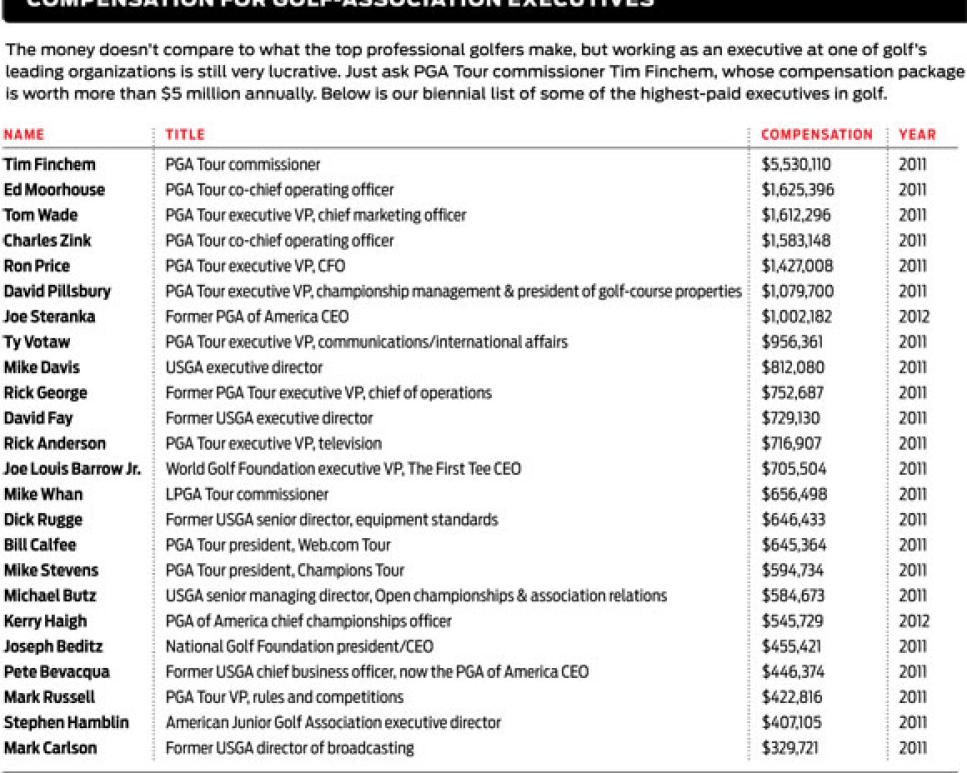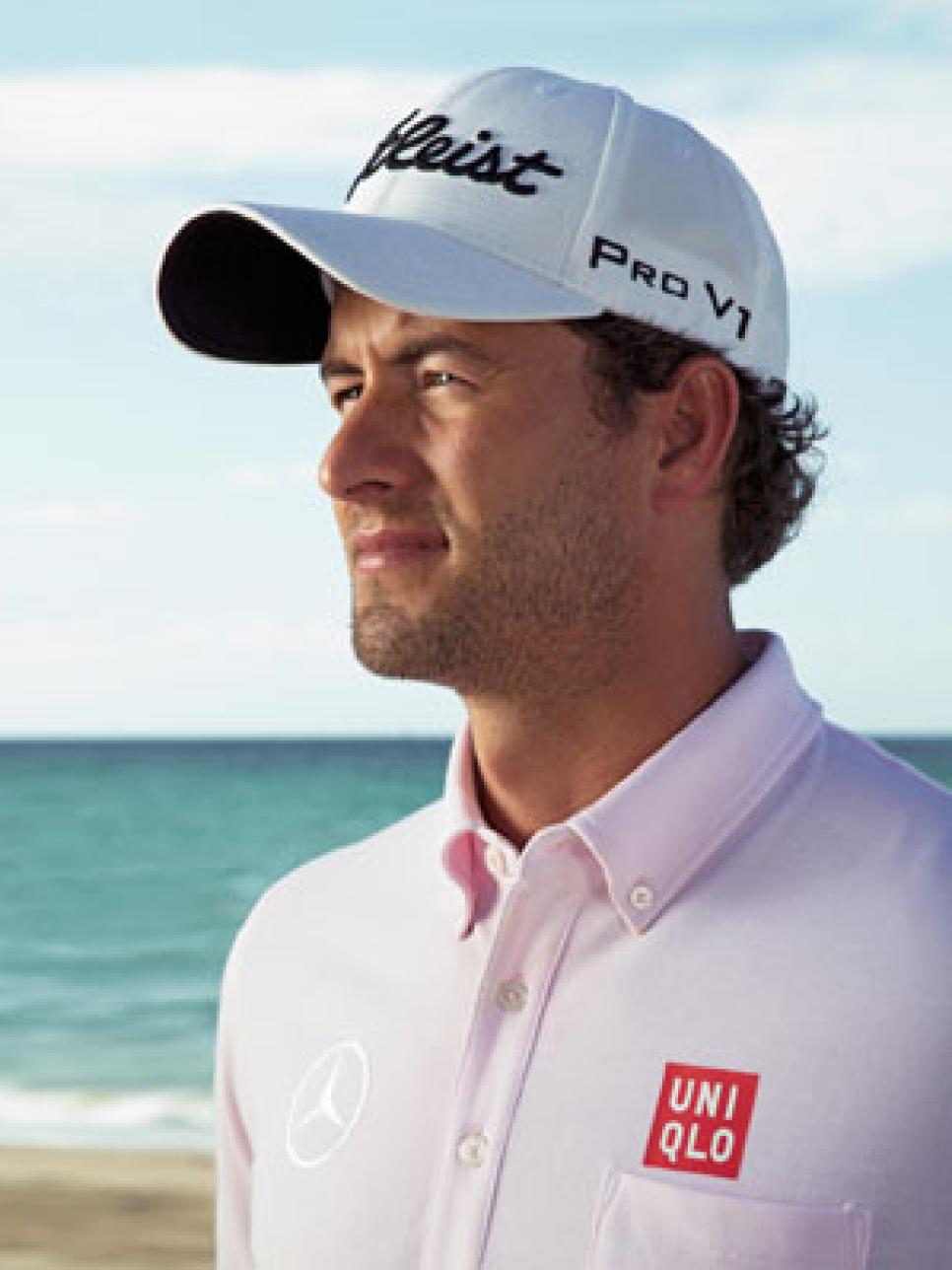News
Cashing In

The formula devised by Mark McCormack for Arnold Palmer in 1960 and extended to Jack Nicklaus and Gary Player at McCormack's IMG agency was called the 90/10 rule: 90 percent of a star athlete's earnings came from off-course business deals, and 10 percent came from winnings. Once you establish star power on the playing field, you convert that into cash off the playing field.
That formula has held for decades in golf, and even with the massive amounts Tiger Woods has won on the golf course—more than $155 million, according to this 11th annual Golf Digest 50 money list—it reflects less than 12 percent of his more than $1.3 billion in career earnings.
But this year's ranking has several examples that the formula is beginning to change, none more glaring than Henrik Stenson, the Swedish player who lost a small fortune when he and others were swindled in the $7 billion Stanford Financial Group Ponzi scheme. Stenson won an astonishing $18,594,670 in 2013—sweeping the Race to Dubai on the European Tour and the PGA Tour's FedEx Cup with its $10 million bonus—to finish No. 5 on the GD 50.
That means that almost 87 percent of Stenson's $21-million-plus in earnings last year came with a golf club in his hand—the opposite of Woods, who has topped the GD 50 all 11 years, and No. 2 Phil Mickelson, both of whom earned more than 85 percent of their money off the course.
As for Palmer, the man for whom the model was created? He had his best year ever at the age of 84, earning $40 million, all of it off the course, thanks in part to a strong year licensing his name on products in Asia. Forty years after his last PGA Tour victory, Palmer is No. 3 on this year's list.
Consider this: Palmer won 62 PGA Tour events, including seven major championships, earning $1,861,857 in career prize money. That would have been No. 39 on just the past year's tour money list. Things have changed. No. 4 on this year's GD 50 is Jack Nicklaus, who earned $9,625 on the course and $26 million off it.
The impact of the prize-money explosion has been significant. There is so much to be won, some players are actually turning down endorsement opportunities, valuing time off more than the added cash and several days' work that the deals require each year. Also, as the PGA Tour has added stops in Malaysia and China, which increased prize money, the amount paid by some tournaments to attract big names—and not-so-big-names—has dipped. The purses, not outrageous appearance fees, now lure players to Asia, where co-sanctioned events still allow appearance fees. "Before that, Jason Dufner would have gotten a $400,000 appearance fee in China after winning the PGA. Now it's more likely $200,000," says one agent who did not want to be quoted by name because he does not represent Dufner. "In Malaysia, it would have been $500,000, and now it's more like $100,000." But in Australia, Matt Kuchar, No. 13 on the GD 50, made $500,000 in appearance fees for two events.
Also hurting some appearance-fee markets is the continued sluggishness of the European economy and its effect on that tour. "The weakness of the European economy cannot be overstated," says Clarke Jones, senior vice president and managing director of the Americas for IMG Golf. "Multinational sponsors are looking to the growing economies in Latin America and are less interested in hanging their hats on individuals. They want to get away from the vagaries of representing human beings. They're looking at multinational investing in a broad range, with organizations and governing bodies and events."
MAJOR VALUE FOR MAJOR WINS
There remains, however, a dependable way to cash in off the golf course: win one of the four men's majors. Though winning a women's major also has an impact, the harsh economic reality is that the vast difference in prize money and TV exposure makes it nearly impossible for LPGA players to make the GD 50 list. This year, only Paula Creamer, the 2010 U.S. Women's Open champion, made the list, at No. 48.
Being a major-championship winner is a gift that keeps on giving. "For the rest of her career, Cristie [Kerr] will be introduced on the first tee as a U.S. Open winner," agent Erik Stevens says of his wife, who won the 2007 U.S. Women's Open. "It's like going from being Elton John to Sir Elton John. The title never goes away."


Photo: Walter Iooss Jr.
Thirty years ago, with much smaller purses on tour, a major winner might chase appearance fees and outings, often to the detriment of his game, in the hopes of turning the win into a million-dollar bonanza. Two days after winning the 2013 U.S. Open at Merion, Justin Rose was on the "Late Show with David Letterman" delivering the popular Top Ten list. The clip became an Internet sensation, and Rose had successfully extended his brand recognition.
According to one agent who spoke on the condition of anonymity, Rose's $1.2 million TaylorMade deal doubled in value after his Open victory. The same agent says Mickelson got a $1 million bonus from Callaway for winning the British Open. A second agent says Rose and Masters winner Adam Scott will earn an extra $3 million to $5 million annually for winning a major.
"Right out of the gate you're going to get an extra deal or two for winning a major," adds another agent, Andrew Witlieb of the Legacy Agency, whose client Jim Furyk won the 2003 U.S. Open.
But even with a major-championship trophy, there are several factors that affect how much a player can cash in. Call them believability, longevity, likability and luck.
Rose and Scott are high on the believability scale. They've been very good players for years, and their major victories are not considered flukes. They're great investments expected to win at least one more major each. Such was not the case when Paul Lawrie, Ben Curtis and Todd Hamilton won the British Open. The money goes to those who are expected to do it again. "There are really two different buckets you have to think about," says Mark Steinberg of Excel Sports, which handles Woods, Rose and Kuchar. "The first involves players like Adam Scott or Justin Rose, who have been top players for several years. They're going to get a significant bump in terms of appearance fees and new endorsement deals. But the first major for someone who is a bit of a journeyman and not likely to win another major is not the same."
Scott and Rose also do well on the longevity scale. They're both in their early 30s and should have at least another decade of high-level golf. Justin Leonard was 25 when he won the 1997 British Open and cashed in big time. That was not so much the case for Mark O'Meara when he won his first major—in fact, two—at 41. All four major winners from 2013—Scott, Rose, Mickelson and Dufner—also do well in likability.
WHICH MAJOR IS WORTH THE MOST?
The luck factor is all about when your endorsement contracts expire. When Lucas Glover won the 2009 U.S. Open, all of his deals were ending. Perfect timing. This is also where believability comes into play. A player on the rise might have his deals extended. A lesser player might be held to his existing contracts.
Which major is the most valuable to win? The overwhelming consensus among more than a dozen agents interviewed by Golf Digest is that the value is in the order in which the majors are played: the Masters, U.S. Open, British Open and PGA Championship. All of those agents say that's not a reflection on the quality of the events, just a matter of where they fall on the calendar.
"The Masters is definitely No. 1 in terms of the most lucrative to win," Witlieb says. "The whole world is tuned in. The U.S. Open is No. 2. The British is No. 3 because it's on in the morning over here. And the PGA is fourth because everyone is on vacation in August."
The Masters is on an island by itself. By the time it has been played in April there hasn't been a major in eight months, and the next major isn't for another two months. "The world gathers under the tree [behind the Augusta National clubhouse], we all know that," says IMG's Jones. "Many discussions start there and end at the U.S. Open or the Open Championship."
The Masters winner has virtually the entire year to be marketed. By the time the PGA has been won, a lot of that money has already been committed.
"Winning a major championship is a windfall. Appearance fees go up so drastically from where a three- or four-time winner on tour might be getting nothing to go overseas to $200,000 to $500,000 an appearance," says Mac Barnhardt of Crown Sports LLC, which has major-championship winners Glover and Davis Love III among its clients.
"Almost all contracts have bonuses tied to winning, and to winning majors," Barnhardt says. "And the bonus for winning a major is two to four times higher than for a regular win. So we're talking bonuses from $100,000 to $500,000 per contract." And if the player has a half-dozen contracts, well, you do the math.
"It's almost impossible not to pick up a deal or two after winning a major," Barnhardt says. "Companies know that the 2013 major winners are going to be on TV a lot in 2014 no matter what they shoot. If your timing is right, you can really cash in."


Steinberg says, "there are going to be tremors."
Photo: Carlos Serrao
TIGER'S HUNT FOR JACK'S RECORD
Woods, who has made himself and other players rich—PGA Tour purses have nearly quintupled since he joined the circuit—remains a fascinating figure. He lost his lucrative EA Sports deal after 2013, but Steinberg says he has something big lined up. It could be that this season is the most significant for Woods, on and off the course. "When Tiger gets his 15th major, there are going to be tremors," Steinberg says. "Winning one and being three majors away [from Nicklaus' record] is a lot different than being four away and not having won a major in five years. It just sounds better. Believability returns."
This is where longevity comes into play. Woods will be 39 at the end of 2014. If he gets major No. 15 this year, the tremors will be much greater than if he gets to that total at age 40 or 42, when the notion of passing Nicklaus' record would seem more remote. Still, Woods is one of the most well-known athletes on the planet. And that makes him worth the eight figures Nike pays him.
Perhaps the most intriguing winner of 2013 is Stenson, who seemed to lose his game early in his career before rising to No. 4 in the world and then plummeting outside the top 200 after the Stanford Financial scandal. There is a believability about him, and at 37 he can be a good investment for several years. And the struggles he has overcome make his likability high.
In February 2009, Stenson found out that Allen Stanford, the head of Stanford Financial Group, with whom Stenson had signed a three-year endorsement deal a year earlier and invested a considerable amount of money, was being charged with "massive fraud" for running a Ponzi scheme. After winning the 2007 Accenture Match Play Championship and playing on two Ryder Cup teams, Stenson had considerable money to invest.
Asked in February 2009 about reports he had suffered seven-figure losses, Stenson told the British paper The Guardian it was "not all my money. But I have quite a big part of my own savings and investments with them." Stenson and other investors, including Vijay Singh and Camilo Villegas, had their accounts frozen. Clearly distracted, Stenson did not win from the 2009 Players until 2012.
"Golf is definitely a whole lot more fun than it was back in 2011," Stenson said after finishing third at the 2013 PGA Championship, a month after being second to Mickelson at the British Open.
It's definitely a lot more fun with prize money at levels the tour pros play for now, sums Mark McCormack could not have imagined when he devised the 90/10 rule more than 50 years ago.
THE GOLF DIGEST 50
ON-COURSE INCOME for 2013 includes all money earned on the PGA Tour and the five international tours (Japan PGA, PGA European, Australasian, Southern Africa, Asian) and the Champions Tour, LPGA Tour, Ladies European Tour and the Japan LPGA through Dec. 1. It includes unofficial money won in nontour events. OFF-COURSE INCOME includes estimates of all money earned from endorsements, bonuses, appearance fees, corporate outings, speaking engagements, licensing fees (video games, trading cards, etc.), course architecture, books, instructional videos and businesses that capitalize on a person's status as a player, such as product lines including clothing, wine and turfgrass. Investment income is not included.
1. Tiger Woods
2013 RANK: 1 | ON COURSE: $12,091,508 | OFF COURSE: $71,000,000 | TOTAL: $83,091,508
2. Phil Mickelson
__2013 RANK:__2 | ON COURSE: $7,009,156 | OFF COURSE: $45,000,000 | TOTAL: $52,009,156
3. Arnold Palmer
__2013 RANK:__3 | ON COURSE: — | OFF COURSE: $40,000,000 | TOTAL: $40,000,000
4. Jack Nicklaus
__2013 RANK:__4 | ON COURSE: $9,625 | OFF COURSE: $26,000,000 | TOTAL: $26,009,625
5. Henrik Stenson
__2013 RANK:__NR | ON COURSE: $18,594,670 | OFF COURSE: $2,850,000 | TOTAL: $21,444,670
6. Rory McIlroy
2013 RANK: 5 | ON COURSE: $2,608,789 | OFF COURSE: $18,000,000 | TOTAL: $20,608,789
7. Gary Player
2013 RANK: 10 | ON COURSE: $9,625 | OFF COURSE: $16,000,000 | TOTAL: $16,009,625
8. Adam Scott
2013 RANK: 19 | ON COURSE: $8,048,068 | OFF COURSE: $7,600,000 | TOTAL: $15,648,068
9. Ernie Els
2013 RANK: 6 | ON COURSE: $2,189,536 | OFF COURSE: $12,500,000 | TOTAL: $14,689,536
10. Greg Norman
2013 RANK: 8 | ON COURSE: — | OFF COURSE: $14,000,000 | TOTAL: $14,000,000
11. Sergio Garcia
2013 RANK: 12 | ON COURSE: $3,411,237 | OFF COURSE: $8,500,000 | TOTAL: $11,911,237
12. Justin Rose
2013 RANK: 13 | ON COURSE: $6,253,672 | OFF COURSE: $5,500,000 | TOTAL: $11,753,672
13. Matt Kuchar
2013 RANK: 25 | ON COURSE: $7,053,225 | OFF COURSE: $3,750,000 | TOTAL: $10,803,225
14. Luke Donald
2013 RANK: 9 | ON COURSE: $2,926,655 | OFF COURSE: $7,000,000 | TOTAL: $9,926,655
15. Steve Stricker
2013 RANK: 34 | ON COURSE: $6,590,532 | OFF COURSE: $3,000,000 | TOTAL: $9,590,532
16. Graeme McDowell
2013 RANK: 17 | ON COURSE: $4,515,205 | OFF COURSE: $5,000,000 | TOTAL: $9,515,205
17. Lee Westwood
2013 RANK: 11 | ON COURSE: $2,889,087 | OFF COURSE: $6,500,000 | TOTAL: $9,389,087
18. Jordan Spieth
2013 RANK: NR | ON COURSE: $4,669,820 | OFF COURSE: $4,500,000 | TOTAL: $9,169,820
19. Dustin Johnson
2013 RANK: 20 | ON COURSE: $4,643,214 | OFF COURSE: $4,500,000 | TOTAL: $9,143,214
20. Jim Furyk
2013 RANK: 16 | ON COURSE: $3,474,779 | OFF COURSE: $5,250,000 | TOTAL: $8,724,779
21. Keegan Bradley
2013 RANK: 23 | ON COURSE: $4,177,480 | OFF COURSE: $4,500,000 | TOTAL: $8,677,480
22. Fred Couples
2013 RANK: 28 | ON COURSE: $2,312,710 | OFF COURSE: $6,000,000 | TOTAL: $8,312,710
23. Ian Poulter
2013 RANK: 26 | ON COURSE: $4,183,433 | OFF COURSE: $4,000,000 | TOTAL: $8,183,433
24. Zach Johnson
2013 RANK: 27 | ON COURSE: $5,154,359 | OFF COURSE: $3,000,000 | TOTAL: $8,154,359
25. Brandt Snedeker
2013 RANK: 7 | ON COURSE: $5,654,337 | OFF COURSE: $2,500,000 | TOTAL: $8,154,337
26. Ryo Ishikawa
2013 RANK: 15 | ON COURSE: $1,483,146 | OFF COURSE: $6,500,000 | TOTAL: $7,983,146
27. Padraig Harrington
2013 RANK: 21 | ON COURSE: $1,333,819 | OFF COURSE: $6,500,000 | TOTAL: $7,833,819
28. K.J. Choi
2013 RANK: 32 | ON COURSE: $1,283,251 | OFF COURSE: $6,500,000 | TOTAL: $7,783,251
29. Jason Day
2013 RANK: NR | ON COURSE: $5,211,697 | OFF COURSE: $2,500,000 | TOTAL: $7,711,697
30. Webb Simpson
2013 RANK: 33 | ON COURSE: $4,683,999 | OFF COURSE: $3,000,000 | TOTAL: $7,683,999
31. Nick Faldo
2013 RANK: 31 | ON COURSE: — | OFF COURSE: $7,500,000 | TOTAL: $7,500,000
32. Jason Dufner
2013 RANK: 30 | ON COURSE: $3,676,268 | OFF COURSE: $3,500,000 | TOTAL: $7,176,268
33. Hunter Mahan
2013 RANK: 24 | ON COURSE: $3,261,164 | OFF COURSE: $3,750,000 | TOTAL: $7,011,164
34. Davis Love III
2013 RANK: 22 | ON COURSE: $352,643 | OFF COURSE: $6,500,000 | TOTAL: $6,852,643
35. Rickie Fowler
2013 RANK: 38 | ON COURSE: $2,206,892 | OFF COURSE: $4,500,000 | TOTAL: $6,706,892
36. Bernhard Langer
2013 RANK: 45 | ON COURSE: $3,094,468 | OFF COURSE: $3,500,000 | TOTAL: $6,594,468
37. Bubba Watson
2013 RANK: 18 | ON COURSE: $2,234,703 | OFF COURSE: $4,200,000 | TOTAL: $6,434,703
38. Charl Schwartzel
2013 RANK: 39 | ON COURSE: $3,658,889 | OFF COURSE: $2,750,000 | TOTAL: $6,408,889
39. Miguel A. Jimenez
2013 RANK: 49 | ON COURSE: $1,605,007 | OFF COURSE: $4,750,000 | TOTAL: $6,355,007
40. Tom Watson
2013 RANK: 35 | ON COURSE: $287,849 | OFF COURSE: $6,000,000 | TOTAL: $6,287,849
41. Camilo Villegas
2013 RANK: 40 | ON COURSE: $888,900 | OFF COURSE: $5,000,000 | TOTAL: $5,888,900
42. Colin Montgomerie
2013 RANK: 36 | ON COURSE: $322,945 | OFF COURSE: $5,500,000 | TOTAL: $5,822,945
43. Harris English
2013 RANK: NR | ON COURSE: $3,727,984 | OFF COURSE: $2,000,000 | TOTAL: $5,727,984
44. Bill Haas
2013 RANK: NR | ON COURSE: $4,042,663 | OFF COURSE: $1,500,000 | TOTAL: $5,542,663
45. Kenny Perry
2013 RANK: NR | ON COURSE: $3,383,804 | OFF COURSE: $2,000,000 | TOTAL: $5,383,804
46. Billy Horschel
2013 RANK: NR | ON COURSE: $4,098,370 | OFF COURSE: $1,250,000 | TOTAL: $5,348,370
47. Nick Watney
2013 RANK: 29 | ON COURSE: $2,845,413 | OFF COURSE: $2,500,000 | TOTAL:$5,345,413
48. Paula Creamer
2013 RANK: 44 | ON COURSE: $831,918 | OFF COURSE: $4,500,000 | TOTAL: $5,331,918
49. Darren Clarke
2013 RANK: 46 | ON COURSE: $281,550 | OFF COURSE: $5,000,000 | TOTAL: $5,281,550
50. Matteo Manassero
2013 RANK: NR | ON COURSE: $1,940,584 | OFF COURSE: $3,000,000 | TOTAL: $4,940,584